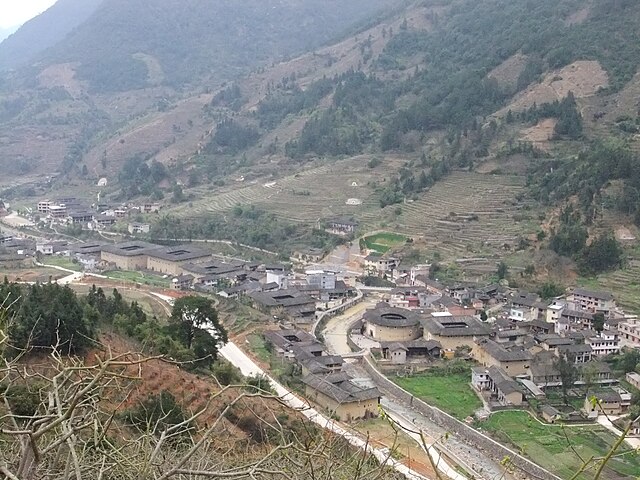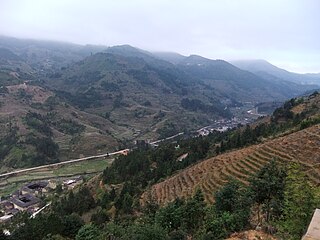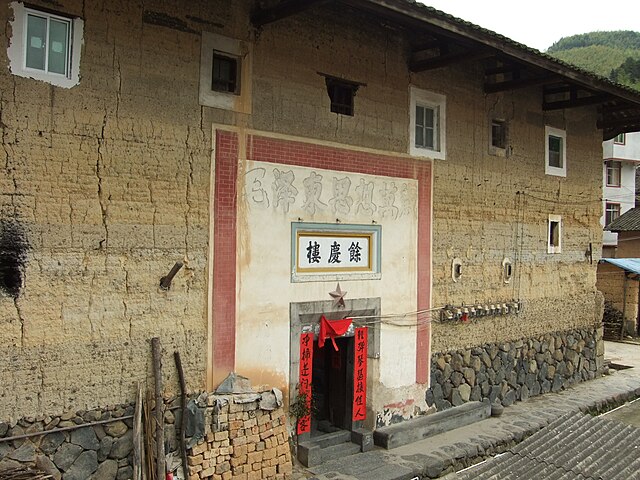 Guibi Lou - just an average tulou from Xinnan Village. Not "World Heritage", like Yanxiang Lou
Guibi Lou - just an average tulou from Xinnan Village. Not "World Heritage", like Yanxiang Lou
After 2 nights in Gaotou Township's Chengqi Lou, I went farther west. In Huang Hanmin's "Fujian Tulou" I had seen a photo of the area that the local tourism promoters call "The Great Wall of Tulous": a chain of villages that mostly consist of tulou and similar adobe buildings, and present quite an imposing picture if viewed from a suitable view point.
Some weeks before, at an early planning stage, I saw that area with Google Maps satellite view almost as soon as I zoomed on the tulou region and started browsing; later, when I actually wanted to find it its exact location on the satellite photos, it took a bit of an effort, but eventually I did find an almost exact match of what the photo showed. The village are located in the valley of the Nanxi ("South Creek") south of Hukeng Town, roughly from Shijia Village in the south to Xin Nancun ("New South Village"; on Google Maps) in the north, and are almost as impressive on the satellite photos as on the photo in the book. So the area is sometimes referred to as the "Nanxi Great Wall of Tulou".
Getting to the "Great Wall" on the ground was easy enough: the new county road continues west from Gaotou to Hukeng, and from there, you take Provincial Highway 309 (S309) to the south. The highway runs along the western side of the Nanxi Valley, while the villages, connected by an old (very poor) road, sit in the valley to the east of the road. This very new highway sometimes made an almost surreal impression: it is a perfect new road with very few vehicles on it, and with only few - and quite poor - connections to the villages where the people are. It is as if the road has been built to serve the tourists and the transit traffic, neither of which are here yet (and the next day, I was to find out why), rather than the locals. However, I saw at least one connector bridge under construction, so hopefully it all will come with time.
 Tulou ruins. Xipian Village.
Tulou ruins. Xipian Village.
 Tulou ruins. Xinnan Village.
Tulou ruins. Xinnan Village.
 Tulou ruins. Yangduo Village.
Tulou ruins. Yangduo Village.
Although my maps very quite unambiguous as to where the tulou villages were, apparently that wasn't as clear to everyone. At some point, a car with a family of tourists came from the south, the driver asking me - and then a more knowledgeable local farmer - "" (So where are the tulou?). That was somewhat discouraging, but I kept going, and after a few more kilometers, the first major tulou village, Xin Nancun, appeared. My maps mentioned that one of the World-Heritage-listed tulou, the Yanxiang Lou, was in the village, but looking from the highway I would have no idea which one it was: the village, stretched along both sides of the Nanxi Creek, had several impressive large round and square tulous, each of which certainly would deserve heritage listing. After a bit of riding and picture taking, I got to a square tulou posted as some kind of Hakka Lifestyles Exhibition; it had apparently been restored and maintained in a decent condition, but there wasn't actually much of an "exhibit" to be seen, beyond, of course, the building itself. The Yanxiang Lou turned out to be nearby as well. While posted with tourist information, it did not have any tickets vendors or tourist crowds, and certainly was pleasant to see.
 In Xinnan Village (Xinnancun)
In Xinnan Village (Xinnancun)
 Inside Yanxiang Lou
Inside Yanxiang Lou
As I went farther south along the tulou villages, I enjoyed the views and took pictures, but I wanted to find a high viewpoint similar to the one used by the photographer who took the photo in Huang Hanmin's book. I climbed a bit along one westbound trail, but it did not seem to provide any useful viewing opportunities. However, a bit later, near Nanjiang Village, a purpose-built winding road climbed a mountain on the western side of the valley, with a sign inviting tourists to visit an observation tower. So I did. You can drive or ride - well, push the bike, most likely - up the road, or you can walk up a shorter but steeper trail through the forest; I chose the latter. The view indeed was worth the climb. However, the tower was not located as far south as the view point of the photographers in the book; looking north, you'd only seen the northern half of what they got.
 The deceased liked psychodelic colors...
The deceased liked psychodelic colors...
 Nanjiang Village, a section of the "Tulou Great Wall", seen from the observation tower
Nanjiang Village, a section of the "Tulou Great Wall", seen from the observation tower

|

|

|
| Nanjiang (center) | Nanjiang (south) | Shijia |
Down on the highway, I kept south, passing another villages (Shijia), where slogans painted above the tulou entrances asked for "10,000 years for Chairman Mao", or at least for Mao Zedong's Thought. I felt I just have to stay for a night there, and try another photo-op chance tomorrow.
 Shijia Village, Dongxing Lou
Shijia Village, Dongxing Lou
I could start my description of the place with "The time has stopped on the cobblestone streets of Shijia", except that there were really no streets there: a cobblestone square between several tulous, then a narrow, pedestrian- or moped-only alley to the next opening, and so one. As I said, the "modern" traffic, such as there was goes on the new highway S309 west of the village, and the old road (which is basically dirt road with some stones mixed in for a good measure) skirts the village from the east.
 Shijia Village. The Cultural Revolution continues!
Shijia Village. The Cultural Revolution continues!
No wonder few tourists ever make it to Shijia. I did not expect to find any travel-related infrastructure there, but there was at least a grocery store there, and when I inquired, on the off chance, whether there is any kind of accommodation (''zhusu'') available in the village, the owner merely responded: "How many people?". As it turned out, he had some nearly empty rooms on the second floor of his, and did not mind renting them out to travelers - and feeding them, too - at a reasonable price. (To be honest, I don't know if he does it regularly, or I was the first person to ask, but if the latter, he certainly was able to think on his feet. I hope that with the new road, more people will come to Shijia and put some money into the pockets of the locals who are willing to rent rooms.)
In a sense, I wish I had a chance to stay in a tulou again, as I had in Gaoutou, but, really, I did not mind being in a fairly comfortable modern house again. And there was a tulou just across an alley...
 Shijia Village, Yuqing Lou. I stayed across
Shijia Village, Yuqing Lou. I stayed across
(2012-03-04)
The one-room grocery shop was, apparently, also a social club of sort for the owner's friends, who'd sip tea or play mah-jong there. I don't speak much Chinese, and the for the region's Hakka people Mandarin also must be a second language, but with a pen and paper we were able to communicate to some extent.
"Coming from Canada, you must know about Dr. X!" (I missed the name).
"Doctor? I am afraid I don't think I know any doctors... What's his name anyway... 白 Bai- 求 qiu- 思 si? No idea!"
"It's not 思 si, it's 恩 en".
白求恩 "Bai-qiu-en... Ah, Dr. Bethune, of course, the hero of the anti-fascist wars in Spain and in China!"
(Dr. Bethune, a Montreal surgeon, died in 1940 while treating Red Army's wounded soldiers during the war against Japanese invaders, and became well known after Mao Zedong himself wrote about him.)
"So you are out there to look at tulous?" A reasonable guess, indeed, as in Shijia you'd see a tulou or a few wherever you look. One of the hospitable grocer's mah-jong partners turned out to be a local history enthusiast. A grandson of a local master craftsman (Jiang Lin'en, 江林恩, a.k.a. Ah Man Shi 阿满师), he proudly showed his collection on books and magazine articles of the tulou country's lore, some of which he (Jiang Shengzhan 江生赞) wrote himself. This was certainly a lot more writing on this topic than I'll ever read in my life... Mr. Jiang kindly showed me around "his" tulou: Nan'an Lou, a rather unusual building, in that it's neither round nor rectangular, but rather D-shaped.
 Shijia: not the best view
Shijia: not the best view
I spent a few hours in mid-day hiking in the hills southwest of Shijia, but could never find a position from which one could get a view exactly like the "Great Wall" photographers did. Either they had a helicopter and a day of an exceptionally good visibility, or they were able to climb a cell phone tower, or the fruit trees which block some of the best views now had not grown at that time yet. Most likely, of course, they simply knew the terrain a lot better than I did.
By mid-afternoon it was time to leave Shijia, if I was to get anywhere else before too late at night. There were several options I could pursue - go back to Hukeng, and then north or northwest toward Yongding or Longyan; backtrack from Hukeng to the east, toward Shuyang and Nanjing County to Zhangzhou; or choose the southern route to Zhangzhou, via Pinghe County. I chose the last option...
Next: The home of the pomelo










